
The Cathedral of Peterborough
Peterborough is not among the best known and neither among the most interesting cities of England. But the city - one hour by train from London away - has one of the most important sights on the whole island, namely the cathedral. It is not only impressive, it has a very old history as well.
Already in the year 655 the first monastery was built here. At that time Peterborough was named Medeshamstede and the first abbot of the monastery was called Saxulf. About 200 years later (870) church and monastery were destroyed by the Vikings. The Hedda Stone reminds of that occasion. Today it is shown in the eastern part of the church.
 |
Tradition says, that the brother of the leader of the Vikings was killed already in the first wave of attack and that the leader took revenge on the monks and let kill them all. They ware alltogether buried in the same grave and as an indicator a carved stone from the church was put on top of the grave. At this time the abbot in office was called Hedda, thus the name of the stone. That means, that this stone is a remnant of the very first church and thus was created more than 1100 years ago. The characters on the stone are said to be Christ, Holy Mary and some of the apostels. |
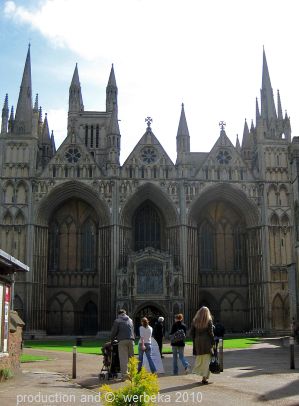 |
Exactly a hundred years later a second abbey stood on this place, this time founded by Benedictines. The penultimate Saxon abbot (before the conquest of the Normans in 1066) was called Leofric. He was a nephew of the rather well-known Lady Godiva.
Even the second church was not to stand there for long. A fire destroyed it in 1116. At the third attempt (1118) the oldest parts of today's church came into existence under abbot John de Sais. It would take 120 years, before the outdoor show-piece, the western front, was finished and the church consecrated.
Around 1500 the church was extended in its eastern part. Here one should behold the marvellous fan-vault. In the 16th century the church was bestowed with its first organ.
Under the reign of Henry VIII came (1533) the separation from the Roman-Catholic church and the Anglican church was brought into life. Six years later all the monasteries were shut down and two years later the church was announced a cathedral by Henry VIII. |
In 1643, one year after the civil war had started in the United Kingdom, soldiers under the command of Oliver Cromwells destroyed all "Roman-Catholic" decorations in the church. Once again it showed that war is the biggest enemy of culture.
At the beginning of our century (2001) the church fell victim to another catastrophy, when again a fire spoiled worths for millions. Though the external damage of that can't be seen by visitors any more.
Today the cathedral is the seat of the Bishop of Peterborough, who commands over 382 churches in Northhamptonshire and Rutland. It is consecrated to the apostels Peter, Paul and Andrew.
As I enter the church I get a positive surprise. It is permitted to take photos.
 |
You have to pay a symbolic fee - I think it was about 2 Euro - but that I do without regret. Because then I can choose my motives with care and I can even use the flashlight. To forbid making photos in public places is anyhow ridiculous. Firstly it is public culture and no copyright can be infringed. Secondly everybody makes his or her photos in any case - it is only that it then has to be without flash and that you must hide what you are doing. |
A big applause to the reasonable administrative management, which in this way at least gets a couple of coins extra!
| But being able to take photos isn't the only surprise after entering the church. One notices immediately the enormous incidence of light through the big windows on either side and the equally enormous length of the main ship.
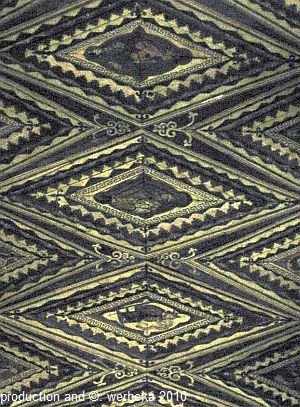
|

The wooden ceiling in the main ship is an artwork from the 13th century. It is painted with apostels, saints and other important people from the history of the church-This is not only unique, but also the only wooden ceiling from that time, that today still is maintained in England.
|
Something else, which I find positive, is the thorough information, that is given in different languages, in form of pamphlets, that are presented in the church. To mention something basic, there is a folded paper in A4-size, which tells not only the history of the church, but also has cues to its sights. Personally I always buy a more elaborate guide, which I need for my research, but I think that for most visitors this folded paper is quite enough.
The first sight, that is mentioned, is the baptistery. The marble font, standing close to the entry, is from the 13th century. The argument for this placement is, that the baptism is one of the first things in a christian life.
Before we walk further into the church, we turn around and see the picture of Old Scarlett on the Western Wall. That man was a grave digger in the 16th century and reached the proud age of 98 years, before his own grave was dug in 1594.
|  |
| He reached his famousness by entombing two queens in his church. To the latter we shall return a little later. First I will give you time study the rhymed inscription under the picture, which is interesting even from a linguistical point of view:
You see Old Scarletts picture stand on hie
But at your feete there doth his body lye
His gravestone doth his age and death time show
His office by theis tokens you may know
Second to none for strength and sturdye limm
A scarbabe mighty voice with visage grim
Hee had interd two queenes within this place
And this townes house holders in his lives space
Twice over. But at length his one turne came
What hee for others did for him the same
Was done. No doubt his soule doth live for aye
In heaven. Though here his body clad in clay.
Noticeable is that the T and H are written as one letter, and that in the first "THERE" the H only consists of the cross between the downstrokes of the T and E.
|
 |
And now to the first Queen, who was entombed here:
It was Catherine of Aragon, the first spouse of Henry VIII. Her life was truly not without blows of fate - the Anglican church came into existence, because the Pope didn't agree on a divorce - but at least she didn't lose her head ...
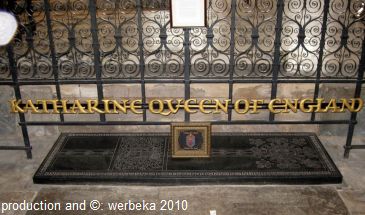
The memorial tablet to the right was donated by the citizens of Peterborough in memory of her 450th anniversary of her decease.
"A Queen, cherished by the English people, for her loyalty, piety, courage and compassion" - that is the inscription. "Humble and Loyale" was her live's motto.
|
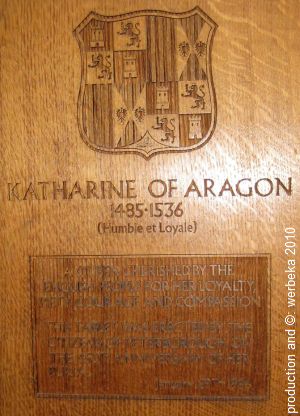 |
|
The daughter of Catherine and Henry VIII became Queen of England as Mary I. She is remembered by history as "Bloody Mary".
The second queen to be buried here, didn't have any easy destiny. This was Mary Stuart, Queen of France and Scotland. She was made bride of Francis II of France (when both were 15), but at the age of 17 she was already a widow. |
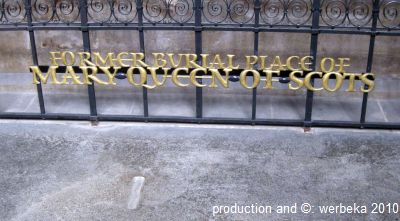 |
| Afterwards her right to become also Queen of England (which she had legal right for) was denied by Elisabeth I, who finally, in 1597, let decapitate her. She was buried in this cathedral, but her coffin was transferred to the Westminster Abbey in 1612. Her earlier place of rest is still shown today in the church, though - exactly on the opposite site of the mainship, compared to Catherine. We shouldn't forget Old Scarlett's age, when he buried Mary Stuart. He was 91 years old at that time!
But the Queens are not the only ones to be buried here. There are the graves of more or less known people, who lie beneath simle stones in the floor, but even those, who got a fancy tomb. On the picture to the right we see the resting place of a local Thomas Deacon and his wife Mary, who were known for their charity.
The Deacons lived in the 18th century, but there are also "modern" deceased, who have been dedicated a memory place in the church.
|
 |
| There is a board given by the British Astronomical Association in memory of George Eric Deacon Alcock, when that amateur astronomer, nature scientist and teacher died in 2000.
Back to the crosspoint of transept and main ship, we lift the eyes to the 44 meter high central tower. The lantern produces much light here as well, so that one can see the wooden carvings on the lock of the lantern. This tower was dissipated stone by stone in 1882, because it had become unsecure. But it was rebuilt in its original version, after the groundwork had been fortified.
In the southern transept we find the St. Oswald's chapel, which is connected with a tale. St. Oswald was the King of Northumbria between 634 and 642. Before that he lived in exile, because the kingdom was stolen from him after the death of his father.
Anyhow, in 634 he came back and conquered the kingdom in the sign of the Cross (and with his soldiers help, I suppose).
|
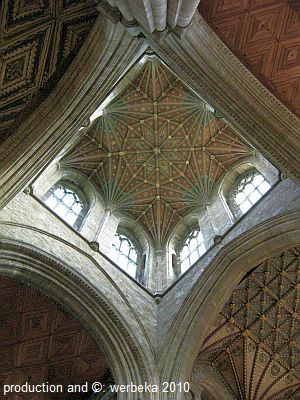 |
But he shall have had a benign approach towards the Christians in any case. After an Easter party together with his friends, he let the rests of the meal, but also the tablesilver be distributed among the poor, who just had survived a hard winter. Bishop Aidan blessed him because of his generosity and spoke the following words: "Might this arm, which is so full of charity never decay."
| In a battle in 642, Oswald lost his life, but his arm was brought back to Bamburgh in Northumberland, where it indeed did not decay. Around the year 1000 a monk stole the arm (may a monk steal?) and brought it to his abbot, who was very fond of relics. St. Oswald's arm became then the most important relic in Peterborough, so that you even today can see the watchtower in the chapel, from which the monks guarded the arm. When the abbey was closed down in 1559 the arm had suddenly disappeared - and until today nobody knows what had happened to it. |
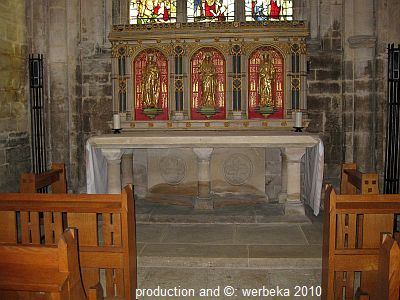 |
In the Northern transept there is the churches treasure room. There one can marvel at collections of sacred siver, ecclesiastic garments, and so forth. But even the transepts for themselves, with their three-storeyed glass windows, are beautiful to behold.
Talking about glass windows: the windows at the eastern front of the chuch have been designed with the fragments of the original, medieval glass windows, which were broken by Oliver Cromwell's pack.
The main altar is worth a second look - or better its composition. It consists of four pillars, behind which there isn't any altar picture, nor anything else, but which leaves a free sight to one of the above mentioned glass windows. The pillars carry also a top piece, which in its lower part is cut out in form of a semicircle, so that the upper curve of the glass window is fully accentuated. This is, in my humble opinion, a very beautiful and unique solution.
|
 |
The choir stalls originate from the late 19th century. The carved figures show diverse people, that are connected to the churches history. The placement of the organ, above the choir stalls, in the main ship's side wall, is also a nice solution. The organ was built in 1894, but restaurated a couple of times since then - not at least after the fire in 2001. Four years later is was placed back as good as new.
Finally we have a look at the dominating cross in the main ship. It was donated in 1975 and designed by the churches own architect at that time, George Pace. The body is made of gilded aluminium and has been created by Frank Roper. The Latin inscription says: "Stat crux, dum volvitur orbis", which approximately means: "The cross is stationary, while the earth turns around".
Copyright Bernhard Kauntz, Wolvertem 2011
|
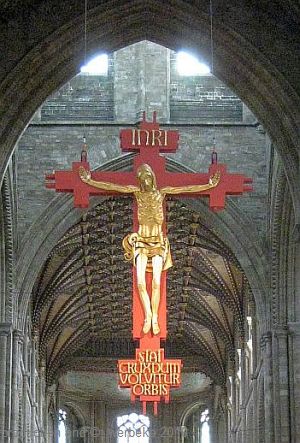 |
Copyright Bernhard Kauntz, Wolvertem 2011
Back to  or to the or to the  of of 
last update: 20.4.2011 by webmaster@werbeka.com
|

















